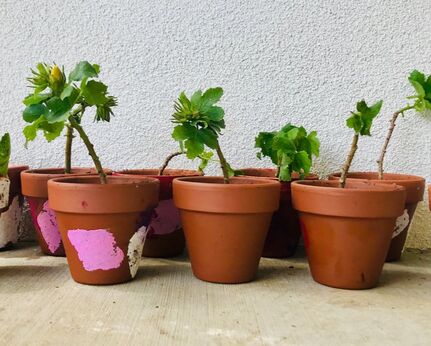|
Cultivating your own plants can be challenging but extremely rewarding. Propagation offers you the chance to get your hands dirty while choosing the plants that are right for you and your area. Here at HOK we encourage you to GROW NATIVE but these propagative skills can be used on all of your favorite cultivars!
Propagation can be separated into two types, sexual and a-sexual. Sexual propagation refers to the growing of seed and a-sexual or vegetative propagation is the growing of plants from collected material. Vegetative propagation allows you to obtain a genetic clone of an individual whereas seed propagation has the potential to create plants with traits from multiple parents. This genetic mixing can be beneficial providing more adaptability through natural selection. Seed that is adapted to your area may germinate faster and be stronger. Offspring may also have slightly different characteristic than their mother plant, like varied flower color or appearance. Seeds are the result of fertilized reproductive organs. In most plants these fertile parts present in the form of flowers! Seed that is considered “orthodox” are those that can be dried and stored. Under the right conditions some seeds can be stored for years, this type of seed will usually have a hard coat or dry fruit. “Recalcitrant” seed are collections that must be propagated immediately. These seeds have a higher oil or water content, cannot be dried and usually appear as fleshy fruit. There are many methods of vegetative propagation. Some of the most common methods are stem cuttings, air layering, budding, divisions and grafting. In this month’s newsletter we will cover the most popular method stem cuttings. A good rule of thumb when sowing seed is to never plant an individual deeper than it is wide. Seeds need to imbibe or take on water in order for them to germinate or sprout. The first emerging sprouts are embryonic leaves called cotyledons. They have developed inside the seed and have enough stored energy to push your plant to the next level. Seeds should be sown with good drainage but in media that retains moisture. Vermiculite or coco coir can be added to retain moisture while perlite or cinders can be used to promote good drainage. Seeds should be sowed in an even layer and kept moist. Try to avoid direct sun and look for an area that has partial shade throughout the day. Seeds can often have some kind of physical or physiological dormancy, both presenting challenges for germination. Physical dormancy can present in in many ways, a good example would be seed that has a waxy coat. This coat prevents water from imbibing and until it is removed or tarnished the seed will remain dormant. Breaking physiological dormancy requires some kind of chemical change with in the seed. Cold stratification or temperature that fluctuates from hot to cold, like cyclic seasonal events can be an example of physiological dormancy. Stem cuttings are one of the most popular methods of vegetative propagation. A good cutting should be the height of a big shaka, about 4-6 inches long. Cuttings should include as many nodes as possible. Nodes are intersection on the plant’s stems, often slightly swollen they will appear as segments or be located at leaf attachments points. These nodes are full of undifferentiated cells, or cells that have the potential to change into roots, shoots or branches. When you find a plant that you want to propagate clip it at a 45 degrees angle, apply rooting hormone to the base and the nodes on lower 2 inches of the stem. You can remove some of the larger leaves and wilted tops at this step, but leave a couple so your plant can produce nutrients through photosynthesis. Plunge your cutting into the media making sure to space each one at least 3-4 inches apart. The 45-degree angle cut, provides a larger surface area for your hormone application and will promote more root growth. Rooting hormone can be in powder, gel or liquid form and found at your local nursery or hardware store, many additional products can be found online. Place cuttings in an area with high humidity in soils with good drainage that retain moisture. Root development is not only dependent on nutrients and water but oxygen available within the media. Avoid direct sunlight and wind as they will aid in drying your propagule. In both cases, success starts with you! A good collection involves harvesting ripe seed and material that is free of pests, healthy and strong.
0 Comments
|
Archives
September 2022
Our MissionThe mission of Hui o Ko`olaupoko is to protect ocean health by restoring the `aina: mauka to makai. This is done in partnership with stakeholders including interested citizens, non-governmental organizations, government, educational institutions and businesses while using and focusing on sound ecological principles, community input, and cultural heritage. Categories
All
|


 RSS Feed
RSS Feed

